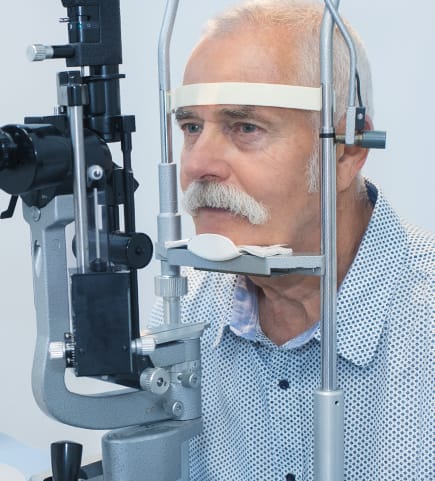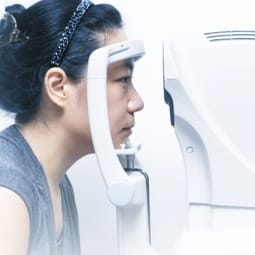Helping You Manage Eye Disease
More than 93 million people in America live with eye diseases that lead to vision loss. Eye doctors can often treat or manage these problems, but only half of all people with an eye disease visit their eye doctor each year.
If you want to protect your eye health and vision, an eye doctor’s help is absolutely essential. The eye doctors at Mira Mesa Optometry can help diagnose any eye disease you have during your next eye exam, then work with you to create a custom plan of action for managing with them.
Don’t let your vision fall victim to an eye disease. Find the help you need at our practice today.
Common Types of Eye Disease
Glaucoma
Glaucoma is a type of eye disease characterized by damage to the optic nerve, which is responsible for sending visual data to your brain. This damage can come from numerous factors, but high pressure inside your eye is one of the most common culprits.
Some types of glaucoma occur quickly and require emergency medical attention, but others can develop quietly for years without obvious symptoms. You likely won’t notice these types of glaucoma until you experience vision loss, so glaucoma tests during routine eye exams are vital for catching it early and reducing its impact. Glaucoma can affect anyone and is one of the most common causes of irreversible blindness worldwide.
Age-Related Macular Degeneration
Age-related macular degeneration (AMD) occurs when the macula begins to deteriorate. This part of your retina is vital for seeing objects in the middle of your visual field, so macular issues of any kind can make common tasks like reading or driving next to impossible.
AMD is a common cause of vision loss for people over 50, and can often lead to severe vision loss without treatment. Having regular eye exams after you turn 50 is the best way to help your doctor detect AMD early and take action to preserve your vision.
Conjunctivitis
Most people call conjunctivitis “pink eye.” It occurs when the membrane on the white of your eye becomes inflamed and turns pink or red.
There are several types of conjunctivitis, including:
- Bacterial conjunctivitis: a type of conjunctivitis spread by bacteria easily transmitted by insects, other people, and hand-to-eye contact. It can form a thick green or yellow discharge in your eyes while you sleep, which could harden overnight and make it difficult to open your eyes.
- Viral conjunctivitis: a form of conjunctivitis often caused by common cold viruses. It’s often spread through coughing or sneezing, but you can also get it by touching your face with unclean hands. Viral conjunctivitis can increase your sensitivity to light and cause white or yellow discharge to form in your eyes.
- Allergic conjunctivitis: a non-contagious kind of conjunctivitis that occurs as an allergic reaction. It’s often caused by exposure to mold or pollen and can present cold-like symptoms. Allergic conjunctivitis can make your eyes itch, water, or feel like they’re burning.
- Chemical conjunctivitis: this variety of conjunctivitis occurs when you get toxic chemicals in your eyes (including liquids, smoke, and fumes). It’s not contagious, but it’s a type of eye emergency that requires medical assistance ASAP to ensure your vision won’t be compromised.
Cataracts
Proteins often form on the normally clear lens of your eye as you get older. These proteins eventually create a milky film called a cataract, which can obscure your vision by turning it pale and cloudy. Some risk factors can also lead to cataracts forming earlier in life.
Cataract surgery can remove most cataracts to help restore clear vision. Cataract surgery typically involves removing the cataract lens and inserting a clear, artificial lens in its place. Our practice can diagnose any cataracts you have and can help you plan to remove them.
Diabetic Eye Disease
Living with diabetes can make you susceptible to diabetic eye diseases like diabetic retinopathy and diabetic macular edema while also increasing your risk for glaucoma and cataracts. Our eye exams can detect signs of these problems early, giving you a chance to manage them before they damage your vision.
Many people with diabetes may also not know they have it. Your eye doctor can often spot potential signs of diabetic eye damage while examining your eyes and alert you to see your family doctor for a diagnosis. Make sure your eyes are properly monitored for these risks and others by booking an exam with us today.


Contact Us Today!

Where to Find Us
Our practice is inside Mira Mesa Mall, just off of Mira Mesa Boulevard in San Diego.
- 8230 Mira Mesa Boulevard, B
- San Diego, CA 92126
Hours of Operation
- Monday: 8:30 AM – 5:30 PM
- Tuesday: 8:30 AM – 5:30 PM
- Wednesday: 8:30 AM – 5:30 PM
- Thursday: 8:30 AM – 5:30 PM
- Friday: 8:30 AM – 4:30 PM
- Saturday: 9:00 AM – 4:30 PM
- Sunday: Closed


Our Brands












